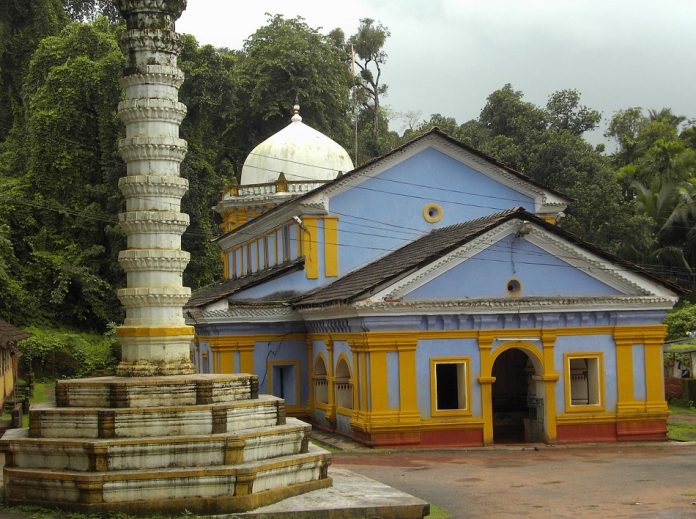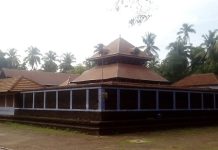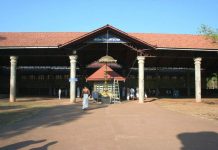
Saptakoteshwar Temple, located in Narve, Goa, India, is a revered shrine dedicated to Lord Shiva. The temple is considered to be one of the six great sites of temples of Lord Shiva in the Konkan area. The temple derives its name from its presiding deity, Saptakoteshwar, an incarnation of Lord Shiva. It holds significant historical and religious importance, attracting devotees and tourists from far and wide.
History
The temple’s history dates back to the Kadamba dynasty in the 12th century, and it has undergone various renovations and restorations over the years. The Kadamba kings, who were devotees of Saptakoteshwar, built the temple for the king’s wife, Kamaldevi. The temple played a crucial role in the lives of the Kadamba rulers, and their coins bore inscriptions referring to Lord Saptakotishwara.
During the Bahmani Sultanate’s rule in the 14th century, the temple faced destruction, and the linga (Shiva’s symbol) was removed by the troops. However, in 1367, the Vijayanagara King Harihararaya defeated the Bahmani Sultan’s army and restored the temple along with many others in Goa. Madhava Mantri, a nobleman, reconstructed the temple by the end of the 14th century.
In 1560, during the Portuguese rule, the temple was demolished, and a chapel dedicated to Nossa Senhora De Candelaria was built in its place. However, some Hindus managed to rescue the linga and smuggled it across the river to Bicholim. In Bicholim, a new temple was constructed, and it was revamped in 1668 under the guidance of Maratha Chatrapati Shivaji Maharaj.
Architecture
The architectural style of Saptakoteshwar Temple is a blend of Hindu and European influences. The temple features a shallow Hindu kalash dome, an octagonal drum, and sloping tiled roofs. The assembly hall, known as the Mandapa, showcases European architectural elements. The Deepastamba, a tall lamp tower, stands as a prominent feature of the temple.
The temple’s surroundings hold archaeological significance, with several Brahminical laterite and stone caves found nearby. The remnants of a Jain Math, a place of worship for Jains, can still be observed in the vicinity. Other notable structures include a shrine of Kalbhairav and the padukas (footwear) of Dattatraya.
Adjacent to the temple, there are two large laterite pillar-like structures buried deep, possibly resembling stone henges. Carved stone walls with niches can be found behind the temple, which might have been an ancient Agrashala, a resting place for travelers. Additionally, there is a man-made tunnel-like structure close to the temple, although it is presently silted.
The temple complex also features a sacred tank known as Panchaganga Tirtha. Devotees use this tank for ablutions on the auspicious occasion of Lord Shiva’s birthday.
Festival
The temple comes alive during festivals, immersing devotees and visitors in a vibrant atmosphere. The annual Mahashivaratri festival attracts a large number of devotees who gather to seek the blessings of Lord Shiva. The temple resonates with the enchanting sounds of prayers, devotional songs, and religious rituals. It is during these festive times that one can experience the fervent devotion and cultural richness of the region.
Temple Timing
Saptakoteshwar Temple welcomes devotees and visitors with open arms throughout the day, from 6 am to 7 pm.
How to Reach
By Air:
For those traveling by air, the nearest airport to Saptakoteshwar Temple is the Goa International Airport. Located approximately 30 km away, the airport serves as a major gateway to the region. From the airport, visitors can hire a taxi or take a pre-booked cab to reach the temple. The journey from the airport to Narve village, where the temple is situated, typically takes around 45 minutes, depending on the traffic and road conditions.
By Rail:
Travelers opting for rail transport can disembark at the Karmali Railway Station, which is approximately 20 km away from Saptakoteshwar Temple. Karmali Railway Station is well-connected to various cities and towns in Goa as well as neighboring states. From the railway station, visitors can hire a taxi or avail themselves of local transportation options to reach the temple.
By Bus:
Reaching Saptakoteshwar Temple by bus is a convenient option for those traveling within Goa. The nearest bus stop to the temple is Marcela Bus Stop, located approximately 4 km away. From Panaji, the capital city of Goa, visitors can board a local bus or hire a taxi to reach Marcela Bus Stop. From there, it is a short distance to Narve village, where the temple is located.
By Road:
For travelers who prefer to drive, Saptakoteshwar Temple can be easily accessed by road. Narve village, where the temple is situated, is approximately 35 km from Panaji. Visitors can take the NH748 highway, which connects Panaji to Marcela, and then proceed towards Narve village. Signboards and directions along the route will guide you to the temple.























































